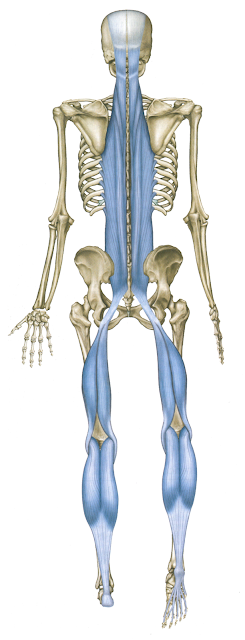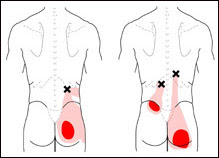
One of the most effective ways to demonstrate an intervention is a before and after, a test and retest. A great party trick, and way to demonstrate the connectedness nature of fascia is to try and touch your toes. Then spend a couple minutes rolling out your arches and bottom of your feet with a golf ball. Again, try and touch your toes and see how much further you can reach.
The increased range of motion occurs because you have released and lengthened the plantar fascia. This fascia is first part of the superficial back line (SBL) outlined by Thomas Myers in his book, Anatomy Trains. As discussed last week, anatomy trains are the lines of bone and connective tissue running throughout the body. These structures, particularly muscle and fascia, organize the structural forces required for motion and link all parts of the body.
The SBL extends all the way up the scalp, including the
Plantar Fascia
Hamstrings
Erector Spinae
As discussed last week, there are only 3 GRF variables, LOAD, EXPLODE, and DRIVE. One of them is likely to be much higher, or much lower than the other two. In this week’s example, if DRIVE is high, relative to FORCE and LOAD, your superficial back line and posterior chain musculature are overactive.

Unfortunately not all of these muscles to the right can be released on your own. Moreover, no one has time for each anterior muscle, so we must focus on the few that are easiest to access and tend to contain the most trigger points. So spend about 1 minute on each side of these areas
Soles of the feet, the plantar fascia
Calves, the gastrocnemius and soleus
Erector Spinae
As mentioned last week, one of the variables in your Movement Signature can be low, so what do you do if your DRIVE is low rather than high?
We know that athletes low on DRIVE must load down deeper, prolonging the amount of time on your load and finishing the extension portion of the unloading. This extension is accomplished primarily by the contraction of the muscles in the back (posterior chain) such as the gastrocnemius and hamstrings. So the opposing muscles (antagonists) would be the flexors, or the anterior chain.
So if your DRIVE is low, the antagonists are likely to be preventing this ability. Therefore, since antagonists tend to be on the opposing side, low DRIVE athletes would need the anterior muscles released and quieted to improve functioning. So focus on the shin and quadriceps to improve ankle and hip extension.
Thankfully, knowing your Movement Signature can give insight into where to focus myofascial efforts, i.e. which muscles you need to roll out.
It’s also good for party tricks…